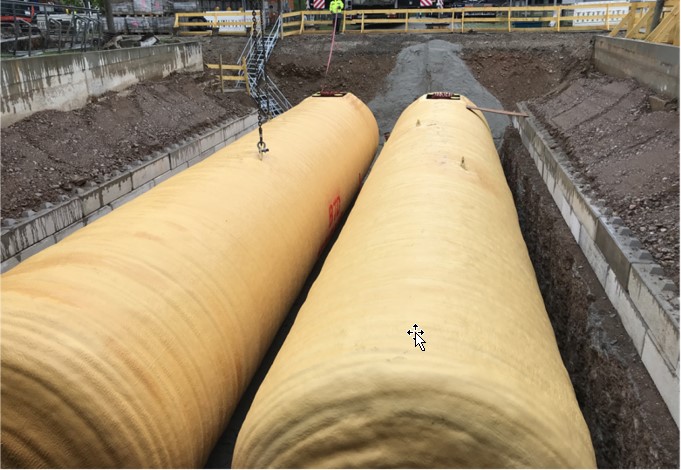Press Release #3
Non-residential Buildings as Flexible Players in the Energy System
The building sector offers great potential for reducing primary energy demand, which the German government aims to reduce by 80 percent until 2050 (compared with 2008). To achieve this, buildings and neighborhoods must be able to respond to fluctuating power generation in the future. As controllable loads or decentralized generators, they will themselves become part of the energy system. In the project "FlexGeber - Demonstration of flexibility options in the building sector and their interaction with the German energy system", the Fraunhofer Institute for Solar Energy Systems ISE conducted three case studies at three different companies. The results are now available in a final report.
The aim of the project, which was funded under the German government's 6th Energy Research Program, was to demonstrate novel heating and cooling technologies as well as solutions for reducing CO2 emissions and integrating renewable energies. In addition to the efficient use and coupling of electricity, heating and cooling, the project tested how industry and the TCS sector (trade, commerce, services) can be integrated into the energy economy. To this end, three case studies were analyzed, the flexibility potential of the existing non-residential building stock was surveyed, and barriers to market and operator models were identified.
"Up to now, the buildings owned by medium-sized industry or the tertiary sector have only been considered in terms of primary energy, rather than as actors in the energy system. Their potential for providing flexibility has been insufficiently researched up to now; a gap that our project has closed," explains Dr. Jessica Thomsen, team leader of Decentralized Energy Supply and Markets at Fraunhofer ISE.
The project has shown how a transformation path to a carbon-neutral future can be found by using a holistic approach for energy systems, even in medium-sized organizations. In this context, self-sufficiency can be increased primarily through photovoltaics in combination with heat pumps or with thermal or electrical storage systems. This reduces energy costs as well as CO2 emissions. However, flexibilization can hardly be realized within the current legal framework and metering technologies. To leverage relevant flexibility potential, the tariff structure for electricity procurement must be reformed, among other things, and the technological prerequisites must be created to make flexibility economically attractive. For example, network charges could be made more dynamic and adjusted to the network or system requirements.
Solutions for electricity, heating and cooling tested
First, an energy system analysis was carried out at the companies Hermann Peter KG Baustoffwerke, the Taifun-Tofu GmbH and at Fraunhofer ISE. For this purpose, the project consortium developed and installed detailed measurement concepts to collect energy data. Based on this data, the scientists at Fraunhofer ISE mapped the energy systems of the case studies in the energy system model DISTRICT and determined the technical potential for flexibilization of the electricity, heating and cooling use.
For example, a refrigeration network and a cold-water storage tank with a volume of 200 cubic meters were installed at Fraunhofer ISE. By replacing several small, decentralized cooling systems with this system, the system efficiency was increased. The cold storage allows a larger part of the load to be covered by free cooling and the refrigeration systems to operate with more flexibility, e.g., with changing electricity price. The important role of heat pumps was also underlined by the project.
"The on-site analyses showed us the possibilities that exist to make the process heat requirement CO2 -neutral," explains Alfons Graf, who is responsible for "Technical Expansion" at project partner Taifun Tofu GmbH. These findings will be taken into account in future investment decisions.
Flexibility potential cannot be exploited without incentives
The flexibility options analyzed by the project team for the non-residential building sector were integrated into a regional and Germany-wide energy system and energy market model, allowing them to assess their interactions with the energy system and the associated impacts. To estimate the negative and positive flexibility potential for Germany, the project team surveyed the non-residential building stock and calculated the flexibility potential for different technologies.
The calculated flexibility potentials were then compared with the forecast residual load (demand for electricity that cannot be covered by renewable energy) for Germany in 2045. This showed that non-residential buildings alone have a relevant flexibility potential, which corresponds to up to 3.2% of the residual energy in 2045.
Another focus of the project was the legal analysis of the barriers that currently prevent the use of flexibility potentials. The analysis was conducted by the Institute for Climate Protection, Energy and Mobility (IKEM), another project partner. The analysis showed that without economic incentives for the provision of flexibility, companies are currently unable to compensate for the financial and non-financial expenditures required to tap the potential.
The project team therefore developed a roadmap and a handout that identify the necessary framework conditions for flexibilization. One key obstacle is grid charges: a reform that promotes electricity demand in line with electricity supply (e.g., incentivizing peak loads in the case of solar power peaks) would make flexibilization more economically interesting.
Last modified:
